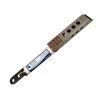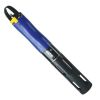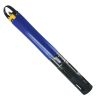SonTek CastAway-CTD
Features
- Can be used for sensor verification, speed of sound profiles, thermocline profiling, and more
- Sampling rate and sensor response of 5 Hz with 1m per second free fall design
- Designed for CTD profiling down to 100m
- Free ground shipping
- Expedited repair and warranty service
- Lifetime technical support
- More
Overview
The SonTek CastAway-CTD conductivity, temperature, and depth sensor incorporates modern technical features which allow fine spatial resolution and high accuracy. The CastAway-CTD uses a six electrode flow-through conductivity cell with zero external fields and a rapid response thermistor to attain high measurement accuracy. The instrument is simple to deploy, does not require a pump, and is hydrodynamically designed to have a free fall rate of 1 m/s.
Built-in GPS Reciever
Each CastAway-CTD cast is referenced with time and location using its built-in GPS receiver. Latitude and longitude are acquired both before and after each profile. Plots of conductivity, temperature, salinity and sound speed versus depth can be viewed immediately on the CastAway's integrated color LCD screen in the field. Raw data can be easily downloaded via Bluetooth to a Windows computer for detailed analysis and export at any time.
Other Features
- Salinity Accuracy: 0.1 PSU
- Temperature Accuracy: 0.05°C
- Small size
- Integrated GPS position
- Real-time display screen
- Wireless data transfer
- 5 Hz sampling rate
| Parameter Specifications | Range | Resolution | Accuracy | Method |
| Conductivity | 0 to 100,000 µS/cm | 1 µS/cm | 0.25% ±5 µS/cm | Measured |
| Density• | 990 to 1035 kg/m3 | 0.04 kg.m3 | ± 0.02 kg/m3 | EOS80•• |
| Depth | 0 to 100 m | 0.01 m | ±0.25% FS | EOS80•• |
| GPS | - | - | 10m | - |
| Pressure | 0 to 100 dBar | 0.01 dBar | 0.25% of FS | Measured |
| Salinity | Up to 42 | 0.01 | ±0.1 | PSS-78† |
| Sound Speed | 1400 –1730 m/s | 0.01 m/s | ±0.15 m/s | Chen-Millero‡ |
| Specific Conductivity§ | 0 to 250,000 µS/cm | 1 µS/cm | 0.25% ±5 µS/cm | EOS80•• |
| Temperature | -5 to +45°C | 0.01°C | ±0.05°C | Measured |
•Based on temperature resolution and accuracy.
••International Equation of State for seawater (EOS-80).
†1978 Practical Salinity Scale
‡ Chen-Millero, 1977. Speed-of-sound in seawater at high pressures.
§ Based on 100,000 µS/cm at -5°C.
- (1) CastAway-CTD with polyurethane jacket
- (3) Magnetic stylus pens
- (1) Bluetooth adapter
- (2) Carabiners
- (1) 15m casting line
- (4) AA batteries
- (1) Maintenance pack (includes cleaning brush, lubricant, o-ring)
- (1) USB flash drive with CastAway Windows software and documentation
- (1) Quick Start Guide
- (1) Hard plastic storage/shipping case
In The News
Science for Science’s Sake: Monitoring Ocean Energy Availability and Gulf Stream Dynamics
Scientific research often begins with a question, sometimes driven by a specific goal or application, but many scientists believe in science for science’s sake. Marine environments and physical dynamics like the Gulf Stream are popular fields of research due to their complexity and importance, presenting a unique opportunity to learn more about previously unexplored phenomena. Environmental researchers, in particular, see the value in these ecosystems, but many also grew up with a passion for the natural world, and choosing a field that allows them to interact with and learn about the environment around us is an easy choice.
Read MoreSonTek CastAway-CTD Meter Review
Lightweight and easy to use, the SonTek CastAway offers a convenient 3-in-1 solution for measuring conductivity, temperature, and depth profiles. At a 5 Hz sampling rate, the CastAway is designed for up to 1 m/s free-fall through the water column. With fast response and accurate conductivity, temperature, and depth measurements, the CastAway is ideal for thermocline and halocline profiling. The unit also reports salinity and speed of sound. [caption id="attachment_38732" align="alignnone" width="940"] Environmental scientist, Katelyn Kubasky, holding the SonTek CastAway in front of the pond at the Fondriest Center for Environmental Studies.
Read MoreMonitoring Kentucky’s Water Resources with Drone Imaging and Unmanned Surface Vehicles
Wesley Turner, an Environmental Scientist Advisor with the GIS and Data Analysis Section of the Watershed Management Branch in the Kentucky Division of Water , spends his days researching current technology and developing various drone programs for the Division of Water. Having grown up during Love Canal and Valley of the Drums, Turner decided at a young age that he wanted to become a scientist and spend his life trying to right humanity’s wrongs and protect the environment. “I loved looking at the plants and animals on the farm where I lived. I wondered at the beauty and mystery of the soil and water in the surrounding fields. As I grew older, I learned of the problems our species caused on the planet […] I remember thinking things had to change,” recalls Turner.
Read More











